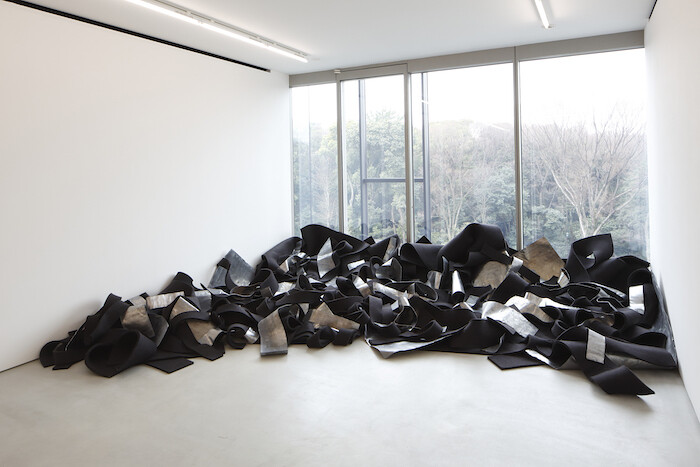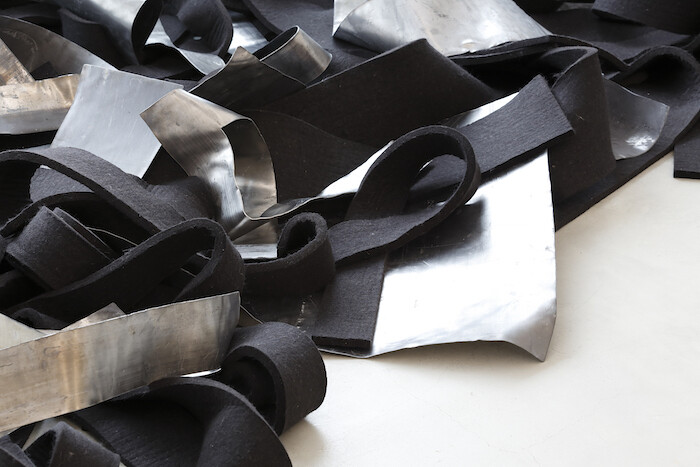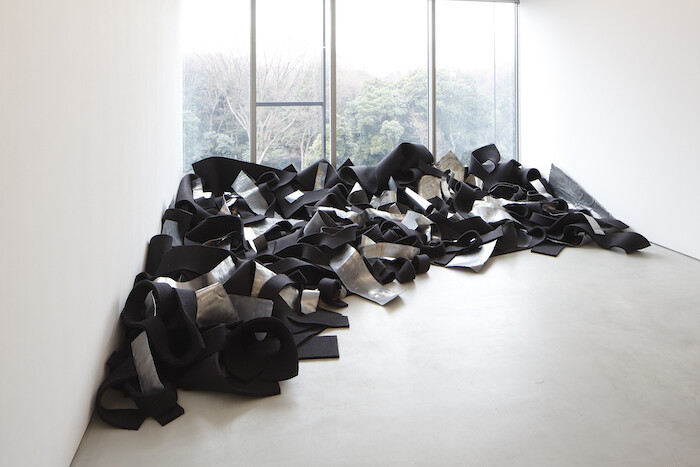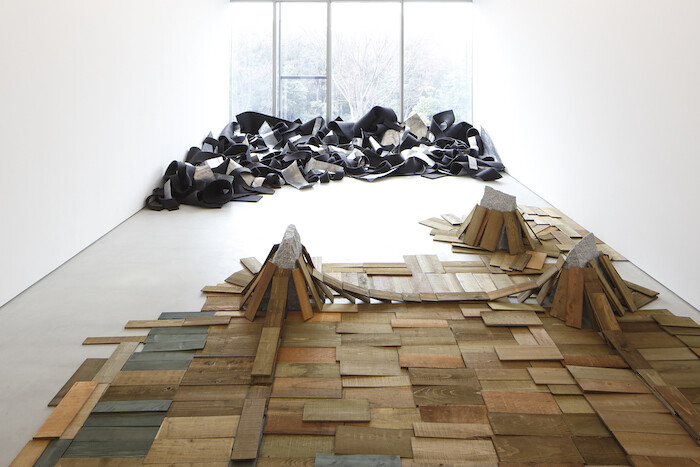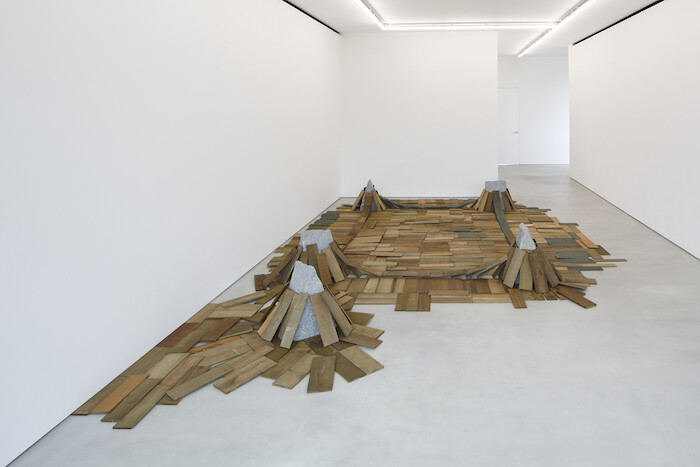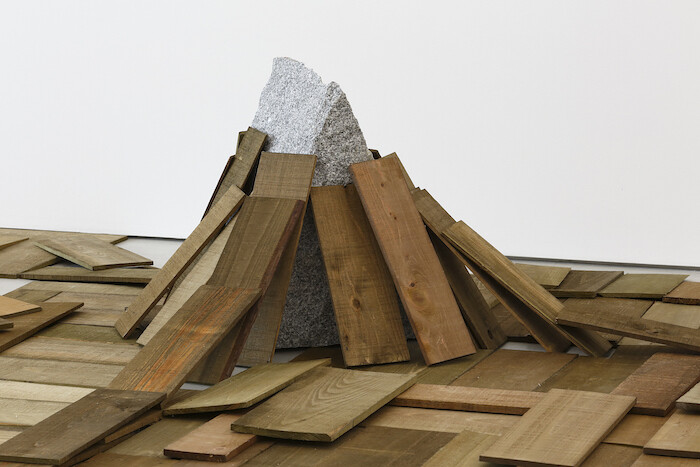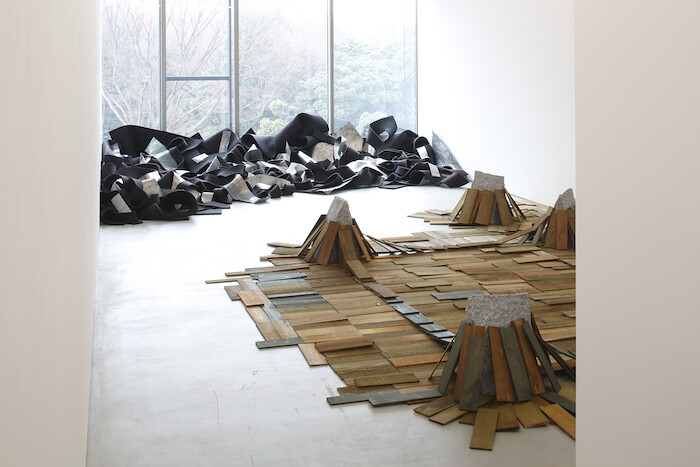Words, like the gray matting in Robert Morris’s Lead and Felt (1969/2016), are woven. Yet, like these felt strips, descriptions shift. In a shared context with Kishio Suga’s Parameters of Space (1978/2016), material and form take on meanings that bend, twist, and track the local climate. The immediate world provides a particular field of reference, the imperfect translation of one language into another. Moving between objects positioned by hand, you can’t help but be aware of their interest in borders and boundaries.
Lead and Felt was originally made for an exhibition at Castelli Gallery in New York, after which it was lost and then remade. Morris came to interpret L-shaped lead and felt strips in later life as an echo of another work created for the show, Scatter Piece (also 1969), that also went missing. Whether exhibited, stored, or thrown into some distant landfill, they became an expression of how transient objects are and how resilient an idea can be. The original Scatter Piece is buried somewhere in New Jersey, casting what Morris describes as a “shadow” over later iterations.
Parameters of Space was made for Kishio Suga’s 1978 solo exhibition at Gallery Saiensu, in Morioka. His interest in borders was laid out in rectangular pieces of wood organized around five granite wedges; the configuration changed with each exhibition, so that the piece formed different relationships with the venue. After each exhibition the work was also discarded—in this case deliberately—and then remade.
At Blum and Poe’s fifth-floor gallery the two works face each other from opposite ends of the same room. Lead and Felt is pushed up against the window overlooking the nearby park and train station; the five blocks of granite stone that establish Parameters of Space map out a more methodical “field.” Surrounded by wooden tiles which pave the floor, Suga’s piece is a counter to the spectacle of Morris’s work. With each “re-staging,” Suga creates situations that illustrate his own relationship with the space, formed from material that teeters on the edge of coming undone. Though ideas are prototyped at his Morioka studio, each reworked piece resists merely replicating previous incarnations by the way it is adapted each time, subject to what Morris refers to as a “continuous process.”
Suga installed his work in person, hinting at a shared history of performance, while Morris was absent. By strapping on his sneakers to construct the work here in Harajuku, a district of Tokyo that has harbored performance and fashion subcultures since the 1970s, Suga offers a gentle reminder of Morris’s involvement with the Judson Dance Theater group and New York’s Living Theater. Both works enact similar preoccupations with form, impermanence, chance, theatricality, and the “break with traditional composition.”1
For Suga the relationship between body and space is one of dependency—of “kyōkūsei” (shared space), “kyōzonsei” (co-existence), “shuzonsei” (gathered existence), “renketsusei” (connectivity), and “renkansei” (linkage).2 Material is presented as a field gathered from things in close proximity, regardless of perspective. This is distinct from a western point of view, according to which “site” is only recognized spatially when experienced visually. Everything is equivalent, and seen in the same light. For Morris, the field is a sea of forces, with Lead and Felt expressed as unstable and indeterminate—twisted, writhing, and aware that if the room were to shake, material would only shift and come to rest like a body in bed.
Whereas Morris’s work is nebulous in spirit, eager to resist definition, Suga’s is both stricter and softer. Both set out to express the world as connected and vital. It is as if they were meant to be seen this way, filling the room and respective landscape with a “dependency”3 on material. “Nature is perhaps the most complex word in the language,” wrote Fredric Jameson,4 and Morris and Suga are constructing competing languages that frame an outside world without falling back on familiar images. Lead and Felt overlooks the street, and seems to slacken as the crowds that jostle outside subside. As the passing sun travels the length of the installation across the day, Parameters of Space softens and bends with each cast shadow.
Rosalind E. Krauss et al, Robert Morris: The Mind/Body Problem (New York: Guggenheim Museum Publications, 1994), 90.
Yuko Hasegawa, “Thoughts on Kishio Suga,” in Kishio Suga: Situated Latency (Japan: He He, 2015), 166.
Ibid., 170.
Fredric Jameson, Keywords (New York: Oxford University Press, 1983), 219.f

